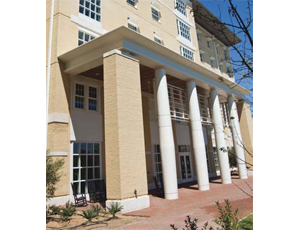The University of South Carolina’s $40-million Honors Residence Hall in Columbia extends the school’s commitment to the environment and sustainability, while integrating classrooms and study areas into students’ living quarters.


“‘Living and learning’ has emerged in the last few years as a national trend,” says project architect Mark L. Timbes, a principal with Garvin Design Group of Columbia. “We did everything we could to get students out of their rooms and to build a community. It improves security and academic scores.”
China Construction of Columbia, S.C., broke ground on the five- and six-story project in October 2007 and finished in August. Heavy rains delayed the job early on, but the team was able to complete it on time, says Lee Bedenbaugh project manager for China Construction.
More than 500 students will call the 191,200-sq-ft building home. Twenty-four students, mostly freshman and sophomores, and a residence adviser will share a common living room, community room and study area. Students will bunk one or two per room. Faculty will teach an honors curriculum on the first floor. Their offices also are housed in the building.
“Research has shown that any time faculty and students interact outside the classroom, students feel more connected to academic life and are more likely to be retained,” says Gene Luna, associate vice president for housing and student development and assistant to the vice provost for special projects at USC. “We wanted strong, publicly visible academic activity happening in the residence hall.”
The university, with its decade-long green initiative, sought LEED gold certification for the project.
“USC has been out front, leading sustainable issues,” says James Sherry, facilities manager for university housing. “Being a flagship, it’s important to set an example.”
Timbes says that primary structural systems are load-bearing masonry—on the upper floors and area “A” of the first floor—over concrete moment frames for first-floor academic and dining functions.
More than 20% of the materials contain recycled content. Crews salvaged blue stone, slate coping during demolition and reused it on the new project. The team also selected regionally available materials.
Daylight streams into 99% of the occupied spaces. The overhangs, inspired by the university president’s house, shade direct sunlight. Students can control their thermal environment. Outside air flows into the building in response to automatic monitoring of carbon dioxide levels.
“Good indoor air quality with lots of natural lighting tends to promote a higher level of learning and a higher level of productivity for staff,” Luna says.
Low-flow fixtures and dual-flush toilets conserve water. A heat-recovery system is designed to help the building use 30% less energy than a typical structure of its size. A kiosk in the lobby will continuously record consumption.
“The key thing for Honors is energy use in the building,” says Michael Koman, USC director of sustainability. “Students can track how much they and their neighbors are using.”
Brick and cast stone clad the exterior. Pervious and reflective pavers allow water to pass and decrease heat load generated by the sun. Trees provide shading. In fact, the university requested that China Construction save many large trees, so crews fenced them off as protection.
“With one tree, we put shoring into the ground and shored that tree while we did our foundations and basement work,” Bedenbaugh says.
China Construction recycled between 85% and 90% of the construction debris. This was the firm’s first LEED project. “We were a little scared, but it went real well,” Bedenbaugh says.
Most importantly, student and university leaders are raving about the new hall, Luna says.
“We expect it to be a special place, where students learn at a high rate and enjoy their university experience,” he adds.
Team Box:
Owner: University of South Carolina
Architect: Garvin Design Group, Columbia, S.C.
Contractor: China Construction, Columbia, S.C.
Design Consultant: Sasaki Associates, Watertown, Mass.
Structural Engineer: Mabry Engineering, Columbia, S.C.
Electrical Engineer: Belka Engineering Associates, Columbia, S.C.
Mechanical & Plumbing Engineers: Swygert & Associates, Cayce, S.C.
Civil Engineer: R.B. Todd, Irmo, S.C.
